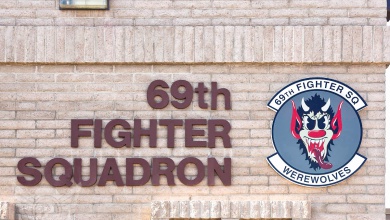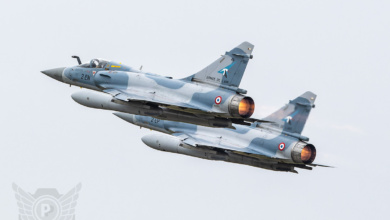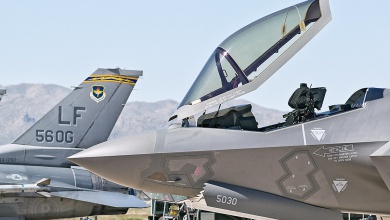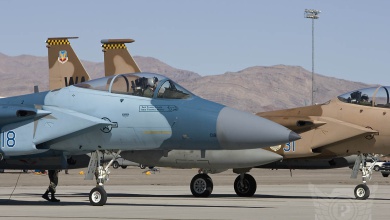While United States Congress struggled with the decision to retire the entire U.S. Air Force Fairchild Republic A-10 Thunderbold II fleet by Fiscal Year 2015, an old Air Force Reserve Command Warthog squadron was resurrected. On March 8, 2014 the 47th Fighter Squadron ‘Dogpatchers’ was re-activated at Davis-Monthan Air Force Base in Tucson, Arizona.
The 47th Fighter Squadron (FS) was formerly part of the 917th Wing based at Barksdale Air Force Base (AFB), Louisiana, acting as an Air Force Reserve Command (AFRC) A-10 Formal Training Unit (FTU). Together with the 81st FS, located at Spangdahlem Air Base, Germany, it was deactivated in Fiscal Year (FY) 2013 due to the National Defense Authorization Act (NDAA) with aircraft from both units being reassigned to the 355th Fighter Wing (FW) at Davis-Monthan AFB under Air Combat Command (ACC). However, that same year Congress also decided on turning one of 355th FW’s three active-duty squadrons into a reserve squadron and transferring all of their A-10s back to AFRC in FY 2014.

Total Force Integration
Back in 2008 U.S. Defense Secretary Robert M. Gates started the initiative for a Total Force Integration (TFI) to take away “the cultural divide that exists between the active and reserve components” he then explained. Gates called upon Congress to “mandate that the National Guard and Reserves have the lead role in and form the backbone of DoD [*Department of Defense] operations in the homeland”. TFI enhanced the ‘Classic Associate’ unit programs in which AFRC squadrons integrate with an active-duty unit, which actually owns and maintains the aircraft. In this construction both active-duty and reserve units retain separate organizational structures and chains of command. Benefits of reserves integrating with active-duty units are mainly continuity, experience and cost efficiency. As more force components have integrated now, TFI has been replaced by the term Total Force Enterprise (TFE) in recent years.
Due to TFI, a new AFRC A-10 FTU was activated at Davis-Monthan AFB to integrate with the 355th FW and was put under command of the 917th Wing at Barksdale AFB as a Geographically Separated Unit (GSU). Knowledgeable of A-10 training, several people from the 47th FS were sent off to Arizona to set up this new unit. Among them was Lt. Col. Terry McClain, who had been flying with the 47th FS as an A-10 instructor pilot (IP) for eight years. He explains: “Six years ago I came here to stand up the 45th Fighter Squadron as a classic associate unit, which meant we had reservists working with the active-duty guys from the 358th and 357th Fighter Squadrons”. The main mission for the 45th FS was to augment the two active-duty FTUs with IPs to maintain the continuity in training new A-10 pilots.
By January 2012 the 917th Wing was split up and while the 47th FS realigned under the new 917th Fighter Group (FG), the 45th FS transferred to the reactivated 924th FG at Davis-Monthan AFB. At that time both Groups were attached to the 442nd FW at Whiteman Air Force Base, MO under subordinate command of Tenth Air Force and operationally-gained by ACC. Later that year, the 924th FG was transferred to the 944th FW (AFRC) at Luke AFB, Arizona.

Classic turns to active
To comply with Congress’ decision to transfer A-10s back into AFRC by FY 2014, Tenth Air Force needed to restructure the 45th FS in order to create an independent A-10 FTU. “We did a flip and went from an classic associate to what we call an active associate” Lt. Col. McClain clarifies. With the 47th FS deactivating around that same time, the AFRC choose to re-designate the 45th FS to 47th FS. “In the toss-up of who had the better history, either the 47th FS or the 45th FS, they decided that they liked the 47th FS better and so the 45th FS became the 47th FS” McClain continues.
While the 355th FW was gaining an active associate squadron, inevitably this also resulted in the deactivation of the 358th FS ‘Lobos’; an active-duty A-10 FTU that resided at Davis-Monthan AFB since 1972. Although the 358th FS officially deactivated on February 21, 2014, the actual responsibility of their part of training A-10 student pilots was already handed over to the newly formed 47th FS by December 2013. The last part of the transfer was made official during a special ceremony led by 924th Fighter Group Commander Colonel John Russell at Davis-Monthan AFB on March 8, 2014. “We gather here to mark the inactivation of the 45th Fighter Squadron, recognize the move of the 47 FS to Davis Monthan and to have Lt. Col. McClain assume command of the 47th and this new unit equipped A-10 training mission” Col. Russell stated in his opening speech “and I’m convinced our training here at Davis-Monthan is the best it has ever been thanks to the total force team”.

Dogpatchers stand up
Lt. Col. McClain, 47th FS Commander, has been involved in the resurrection of the Dogpatchers here at Davis-Monthan AFB from the very beginning. “We got told about the change a year ago, so we spend from basically February ’13 until February ’14 getting everything ready for the change. We took over pretty much all of 358th’s equipment, so they transferred the planes, the squadron building and all the equipment that was in the building already. We have 28 planes; technically it is a 24 PAA (Primary Assigned Aircraft) squadron, but they gave us 28 because some of them are torn apart for extensive maintenance.”.
Once everything was prepared, the squadron stopped flying for two days to switch personnel and have IT activate the new computer accounts. McClain continues: “After those two days we started flying our schedule, which has slightly being reduces; the 357th FS flies over 20 sorties a day and we are now flying a little over 10, because we don’t have the people to do more right now.”.
The squadron currently has 12 full-time and 9 part-time reserve instructor pilots and is augmented by another 10 active-duty pilots that came from the 358th FS. As some of them will transfer out soon, McClain is putting in effort to fill those positions with more reserve pilots. Most candidates are actually active-duty pilots from the Tucson area that want to join the Reserves in order to avoid transferring. There are however some specific criteria for the job McClain explains: “We are an FTU, so in order to do that, you either got to be an FTU IP already or we have to put you through that being an A-10 IP already. So that limits the number of potential candidates.”.
We did a flip and went from an classic associate to what we call an active associate. Lt. Col. McClain


Warthog training
Davis-Monthan AFB is the sole training base for the entire A-10 fleet with both the active-duty 357th FS and reserve 47th FS providing equal training programs. All new student pilots selected to fly the A-10 are active-duty and will enter the six-month B-Course program directly after finishing primary flight training. These Lieutenant classes usually have 10 to 12 students and between the two squadron there are four classes each year. Since the A-10 is a single-seat aircraft only, it is essential for the students to get a decent amount of simulator time before their first flight. “We simulate all the problems that they are potentially going to see before their first flight. And even the first flight, when they take off, we are flying right behind them watching everything they do.” according to Commander McClain. “Like watching a baby walk for the first time; you are very careful and paying close attention.”. Instructor pilots are especially trained to foresee and anticipate on any problems students might have during their first stage of learning how to fly the aircraft. “Before that student takes off for his first sortie, I know 99% of the things he is going to do wrong already. On top of that the aircraft is very simple to fly; it is more the employment of the weapons where it gets complicated and where students get problems. Keeping track of all the things going on at once is the difficult part.” McClain concludes.
After their first flight, the students will learn the basics on instrument flying and how to recover from aircraft stalls as well as other problems they might encounter. This is followed by several air-to-air sorties and formation flying. From there they will enter the so-called ‘basic surface attack’ phase, which is all about dropping bombs and shooting the A-10’s GAU-8/A Avenger gun against ground targets. Later this will be enhanced by flying these sorties in various tactical scenarios and a big dose of night time flying. A final mission check ride will conclude their training curriculum and as fully qualified A-10 pilots they will be sent to the combat units. Providing the best combat training for these new aviators is crucial as McClain points out: “We have literally had people that graduated here and their next sortie was flying in Afghanistan!”. And although an FTU like the 47th FS will never deploy for combat, Reserve IPs regularly volunteer to join a combat squadron on deployment to stay current on the latest developments in the field and take that experience back to train others.

Besides B-Courses, each A-10 FTU also runs up to eight, so-called TX-Courses, per year. These transition courses are designed for pilots transitioning to the A-10 from flying another fighter aircraft, like the F-15 or F-16. Also A-10 pilots that need to re-qualify on the jet due to staff tours or extensive schooling will go through a modified TX-Course at Davis-Monthan AFB. TX classes are usually rather small with about 4-5 pilots and custom scheduled by demand.
The FTE concept has especially proven itself to be of great value for FTUs, as on average active-duty personnel rotates every three years opposed to reserve personnel that will remain in the squadron for a longer period of time. Besides the continuity advantages, most reserve IPs have had long-time active-duty careers, so they will bring a huge amount of experience and expertise to train new aviators. It is also more cost-efficient as reserve units have a smaller footprint and a lesser frequency in training new IPs. Other advantages is having Unit Training Assembly (UTA) weekends, which is a monthly training routine among Reserve and Air National Guard units. The 47th FS utilizes these UTAs to make up for any loss of course training during the week due to equipment failure, weather conditions or any other unforeseen problem.

Li’l Abner
The history of the 47th FS dates back to December 1st, 1940 when it was activated as the 47th Pursuit Squadron at Wheeler Field, Hawaii. With comic strip characters being very popular nose art decorations among squadrons those days, the 47th started applying various characters from the popular comic strip ‘Li’l Abner’ by Al Capp to their aircraft. These characters all lived in a placed called Dogpatch, which resulted in the squadron being nicknamed the ‘Dogpatchers’. As cartoonist Al Capp actually gave the 47th FS full permission to use these characters, the squadron has kept the tradition alive and continues to carry Li’l Abner artwork on their A-10s. Besides the drawings, also the typical language used by the characters has proven to be very influential as words/expressions still used today like ‘skunk works’, ‘amoozin’, ‘double whammy’, ‘hogwash’ and ‘Sadie Hawkins Day’ all originated from this comic strip.

Other markings applied to 47th FS aircraft include a distinct warthog nose-art that all of their A-10s exclusively carry. Although many aircraft of the 47th FS still carry former unit markings and the ‘BD’ and ‘DM’ tailcodes, eventually all their A-10s will be re-painted with artwork and the new ‘DP’ tailcode. When asking whether this abbreviation was chosen to represent their nickname ‘Dogpatchers’, Lt. Col. McClain commented: “Officially the ‘DP’ tailcode stands for ‘Davis-Monthan’ and ‘Pusch Ridge’, which is one of the mountains over here, but it is very convenient that it has worked out this way!”.
The entire A-10 fleet upgraded to A-10C with data link capability
It is much easier to share information between planes where as to prior to that I had to radio and tell my wingman. Now we can do all that electronically, so it makes the information transfer much easier.
Lt. Col. McClain
Future perspective
Although specifically designed for Close Air Support (CAS) in the early 1970s, over the years the A-10 Thunderbolt II has actually proven to be a valuable asset in conducting Combat Search And Rescue (CSAR), Forward Air Controller-Airborne (FAC-A) and Strike Coordination And Reconnaissance (SCAR) missions as well. From 2005 until 2011 the entire A-10 fleet was upgraded to A-10C with major improved capabilities such as utilizing precision guided munitions, either GPS enabled bombs or laser-guided bombs. Another big improvement was the data link capability. “It is much easier to share information between planes where as to prior to that I had to radio and tell my wingman.” according to Lt. Col. McClain; “Now we can do all that electronically, so it makes the information transfer much easier.”.

Earlier this year U.S. Defense Secretary Chuck Hagel argued that retiring the entire A-10 fleet will save $3,5 billion over five years, which could be used to accelerate the USAF’s modernization plan in replacing several types of older aircraft with the new F-35 by 2020. While the aging A-10 is getting more difficult and costly to maintain, other types of aircraft such as the F-35 or remotely operated drones are also capable of executing the A-10’s core task of CAS missions. Retiring any other number than the entire A-10 fleet seems not an option as the fixed costs for the type specific support are still substantial. As McClain puts it: “Right now we are all in ‘wait and see’ mode.”. Congress has made the decision to keep the A-10 flying for at least another year, which is partly good news for the Warthog community although the uncertainty for things to come remains. Nevertheless these units keep supporting any mission they are called upon with their professional attitude, excellent skill set and dedication to their biggest fan base; the troops in the field.


Command structure
944th Fighter Wing [AETC] – Luke AFB, Arizona
924th Fighter Group [ACC] – Davis-Monthan AFB, Arizona
| squadron | type | nickname | code | function | note |
| A-10C* | ‘Hogs’ | DM | A-10 FTU | *owned by 355th FW / became 47th FS | |
| 47th FS | A-10C | ‘Dogpatchers’ | DP | A-10 FTU |
355th Fighter Wing [ACC] – Davis-Monthan AFB, Arizona
355th Operations Group
| squadron | type | nickname | code | function | note |
| 354th FS | A-10C | ‘Bulldogs’ | DM | ||
| 357th FS | A-10C | ‘Dragons’ | DM | A-10 FTU | |
| A-10C | ‘Lobos’ | DM | A-10 FTU | disbanded |
Additional photos










Acknowledgement
Phodocu would like to thank 47th Fighter Squadron Commander Lt. Col. Terry McClain, 944th Fighter Wing Chief Public Affairs Maj. Magnusson as well as Chief Public Affairs Capt. Harrington, 1st Lt. Ranaweera and everyone else at the 355th Fighter Wing Public Affairs for their effort and support.




